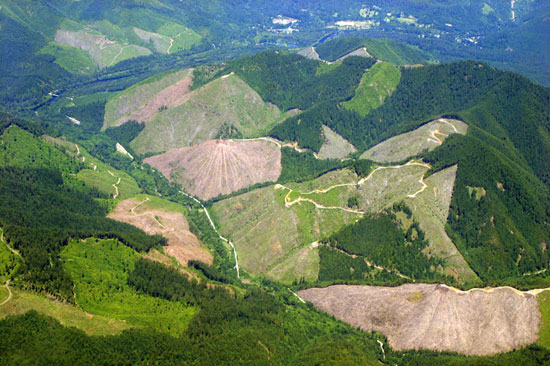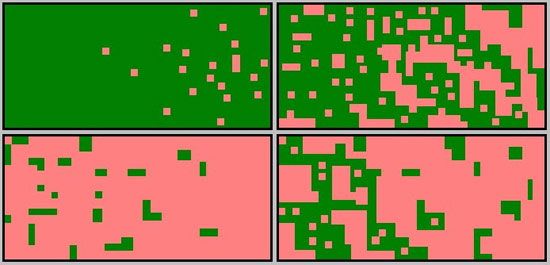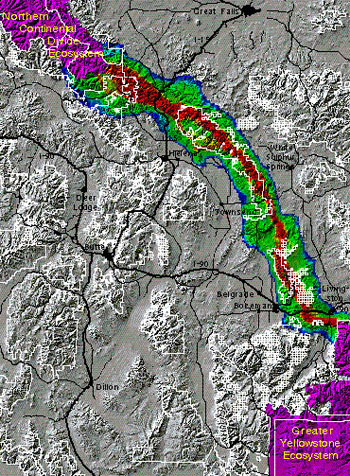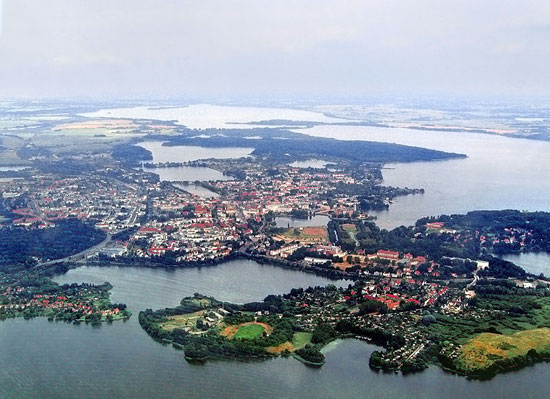21.2: Applications of Landscape Ecology
- Page ID
- 92910
\( \newcommand{\vecs}[1]{\overset { \scriptstyle \rightharpoonup} {\mathbf{#1}} } \)
\( \newcommand{\vecd}[1]{\overset{-\!-\!\rightharpoonup}{\vphantom{a}\smash {#1}}} \)
\( \newcommand{\id}{\mathrm{id}}\) \( \newcommand{\Span}{\mathrm{span}}\)
( \newcommand{\kernel}{\mathrm{null}\,}\) \( \newcommand{\range}{\mathrm{range}\,}\)
\( \newcommand{\RealPart}{\mathrm{Re}}\) \( \newcommand{\ImaginaryPart}{\mathrm{Im}}\)
\( \newcommand{\Argument}{\mathrm{Arg}}\) \( \newcommand{\norm}[1]{\| #1 \|}\)
\( \newcommand{\inner}[2]{\langle #1, #2 \rangle}\)
\( \newcommand{\Span}{\mathrm{span}}\)
\( \newcommand{\id}{\mathrm{id}}\)
\( \newcommand{\Span}{\mathrm{span}}\)
\( \newcommand{\kernel}{\mathrm{null}\,}\)
\( \newcommand{\range}{\mathrm{range}\,}\)
\( \newcommand{\RealPart}{\mathrm{Re}}\)
\( \newcommand{\ImaginaryPart}{\mathrm{Im}}\)
\( \newcommand{\Argument}{\mathrm{Arg}}\)
\( \newcommand{\norm}[1]{\| #1 \|}\)
\( \newcommand{\inner}[2]{\langle #1, #2 \rangle}\)
\( \newcommand{\Span}{\mathrm{span}}\) \( \newcommand{\AA}{\unicode[.8,0]{x212B}}\)
\( \newcommand{\vectorA}[1]{\vec{#1}} % arrow\)
\( \newcommand{\vectorAt}[1]{\vec{\text{#1}}} % arrow\)
\( \newcommand{\vectorB}[1]{\overset { \scriptstyle \rightharpoonup} {\mathbf{#1}} } \)
\( \newcommand{\vectorC}[1]{\textbf{#1}} \)
\( \newcommand{\vectorD}[1]{\overrightarrow{#1}} \)
\( \newcommand{\vectorDt}[1]{\overrightarrow{\text{#1}}} \)
\( \newcommand{\vectE}[1]{\overset{-\!-\!\rightharpoonup}{\vphantom{a}\smash{\mathbf {#1}}}} \)
\( \newcommand{\vecs}[1]{\overset { \scriptstyle \rightharpoonup} {\mathbf{#1}} } \)
\( \newcommand{\vecd}[1]{\overset{-\!-\!\rightharpoonup}{\vphantom{a}\smash {#1}}} \)
Themes of Study and Application
The development and dynamics of spatial heterogeneity in landscapes is a central theme of ecological studies, especially the effects of conversion of natural ecosystems into human-dominated systems such as agricultural or urban land use. As natural habitat is altered in a landscape (both the composition (forest area) and the configuration (spatial pattern of patches) change. This conversion is called fragmentation (Figure \(\PageIndex{1}\)). Evidence is mounting that change in composition has a dominant effect on composition of the biota, whereas variation in configuration has a lesser effect, except at very low proportion of patch composition in the landscape. Such ideas have practical consequences for the conservation of biodiversity. Rhetorically, “will protection of a Single Large patch of habitat or Several Small patches (the SLOSS tradeoff) have equivalent effects on species persistence or biodiversity?"

Another theme relating configuration and conservation is the potential value of corridors linking habitats. Across large parts of the globe, biodiversity is affected by the interactions between climate changes and landscape linkages, and land use, which may block (barriers) or enhance (corridors) species persistence. Although ecologists have debated the scientific evidence concerning the effect of corridors, like SLOSS, the idea of landscape linkages has intuitive appeal for conservation. For example, conservationists interested in large predators have used knowledge of their movements, coupled with habitat data in GIS analyses, to identify focal areas for conservation corridors (Figure 2). Conversely, when the motivating question is related to the spread of an invasive insect like emerald ash borer (Agrilus planipennis), or an emerging infectious disease like avian influenza, then corridors and patches that act as stepping stones have negative rather than positive value. Recent combinations of population genetics and landscape ecology have strengthened the ability to understand how species respond to landscape change, because they have the potential to reveal patterns of dispersal linkages and barriers across extensive regions. Landscape genetics provides a conceptual framework and tools to link the ecological short-term and local spatial scale with the long-term and large spatial scale helpful in understanding adaptation.

Although there has been much research emphasis on how organisms respond to landscape heterogeneity, it is important to recognize that organisms comprise the heterogeneity, and often cause it themselves. For example, herbivores as different as bison (Bison bison) and prairie dogs (Cynomys spp.) influence large scale distribution of vegetation types and microhabitats in North American prairies. In natural systems, organisms may have the same ecosystem engineering effect as the pervasive influence of humans, although the effect of human influence has been the focus of far less attention in the development of landscape theory.

Ecosystem and landscape scientists share a common interest in how spatial heterogeneity affects abiotic and biotic processes in ecosystems. Whether the compartments are abstract units of an ecosystem model or patches on a landscape, scientists are developing a unified framework to understand the dynamic flows of materials such as water, nutrients, and chemicals, both in time and space. The ideas can be applied to suggesting strategies for managing soil fertility and erosion, nutrient cycling, and pollution.
Solving such problems requires the consideration of continuous environmental gradients, requiring the integration of approaches used in geomorphology, surface analysis, and spatial statistics. This interest has led to the emergence of a dynamic mosaic paradigm, which complements the patch-corridor-matrix paradigm. Landscape concepts regarding loss and fragmentation of vegetation cover around the world have become fundamental to understanding the carbon cycle, and predicting the consequences of global climate change.

More than 75% of Earth’s ice-free land shows evidence of alteration as a result of human residence and land use. Furthermore, the legacy of anthropogenic land use and natural events, like fire, is clearly important and has measurable effects on ecosystem function, even hundreds of years after landscape alteration. This anthropogenic scaling is fundamental to most ecological processes in this landscape. Natural processes that affect the stability and resilience of ecosystems apply equally well in wild lands and the vast majority of the biosphere where humans live (Figure 4). The challenge to landscape ecologists is to meld the ecology-centered spatial view with the society-centered holistic view to the benefit of understanding how spatial-temporal heterogeneity affects the resilience of the ecosystems of the earth on which all organisms depend.

